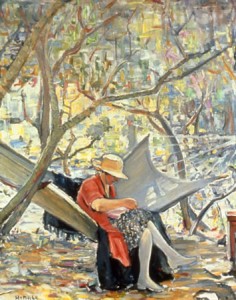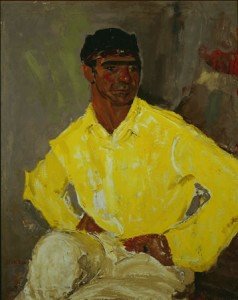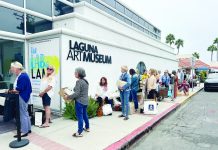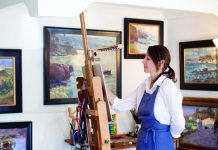
One of Laguna Beach’s streets bears his name, like just a few other lanes christened with the monikers of other early fellow artists William Wendt, Frank Cuprien and Rosa Bonheur.
Yet despite his early influence, Clarence Hinkle has not been the subject of a major retrospective of his work in more than 50 years.
The Laguna Art Museum makes up for lost time when the exhibition “Clarence Hinkle” opens to the public Sunday, June 10. The museum’s curator of collections and registrar Janet Blake spent two years developing the show, thematically arranged to help reveal the creative breadth of an artist “in love with painting” throughout his entire life.
Hinkle visited Laguna Beach in 1917. Newly wed to his Canadian-born wife Mabel, the couple moved here in 1922 and built a house in Arch Beach. He reportedly painted several vistas from his porch. While not a founding member of the Laguna Beach Art Association (the group that founded the 1929 gallery which evolved into the museum), he became an active member and served on its board for 14 years.

Often lumped together with California Impressionists or plein-air painters, Hinkle is much more than that. Instead, he is emblematic of California painters who came of age during the turn of the 20th century and whose ambitious and adventurous spirit led them to travel and study throughout the eastern United States and in Europe where study of local artists helped shape their own creative expression. What’s more, Hinkle left a lasting legacy in his students, including Phil Dike and Millard Sheets, whom he encouraged to swap out cumbersome oil paints for watercolor when painting outside.
Stylistically he recalls a gamut of Europeans, among them Cézanne and Bonnard, Van Gogh and Matisse and even Picasso, but it’s clear that even after much travel and absorption of influences, he remained his own man.
Looking at Hinkle’s “Coastline Laguna,” a landscape done around 1924, one will take note of his prolific use of black, a no-no among many artists of that time. His characteristically rapid and sketchy brushwork depict “Laguna Beach North,” done a year later. Then again, “Light at Sunset Laguna,” painted in the same year, appears almost abstract due to use of heavy impasto not often seen in his work. (The above painting contains a small depiction of the “Pirate Tower,” a fanciful structure for a spiral staircase, a historic structure at Victoria Beach.) “Some paintings appear abstract up-close but, stepping back, they become clearly representational,” noted Blake, referencing “…Sunset.”

Hinkle’s figurative paintings, including a prodigious self-portrait whose lighting recalls Dutch masters, are as challenging to classify as “Cannas over the City,” c 1941, a still-life placed intriguingly into the context of a cityscape. Apparently Hinkle spent a lot of time in carefully arranging and painting still-lifes that, due to their intrinsic story telling, engaged Blake. “I am passionate over still-life paintings,” said Blake, who describes them as anything but “still,” filled with enough clues to allow viewers to supply their own narrative.
It’s said that Hinkle became more “conservative” after moving to Santa Barbara, where he died on July 20, 1960. But paintings done after the couple’s move do not appear to have lost their intensity (“In the Oak Woods” c 1941 and several still-lifes) even if some later landscapes became more literal and lighter in atmosphere.
Hinkle belonged to The Group of Eight, whose 20 works comprise a companion show curated by Susan M. Anderson and shown in the museum’s California Gallery.
Reflecting the art and culture of Los Angeles in the 1920s, the group also includes Mabel Alvarez, Henri De Kruif, John Hubbard Rich, Donna Schuster, E. Roscoe Shrader, Edouard Vysekal and Luvena Buchanan Vysekal. Also present in their scene was Gjura Stojana, a modernist painter, sculptor, muralist, world traveler and an all around exotic figure whom Hinkle immortalized in a portrait recalling German Expressionism, minus the inherent angst. They were studio rather than plein-air painters using a variety of genres to express themselves and their take on the times they lived in in an original manner that owed little to European influences.
A generously illustrated hardcover book with comprehensive essays by Janet Blake and Susan M. Anderson accompanies both exhibits.





[…] painters you probably never heard of.” ~ Richard Chang, The Orange County Register . >> Laguna Beach Independent . >> Coastline Pilot . >> OC Social Scene . >> The Orange County Register . […]